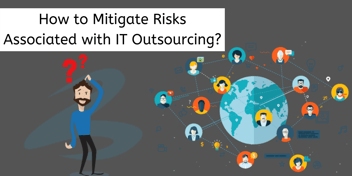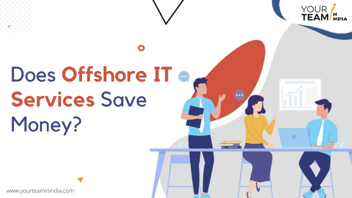Outsourcing IT services has long been a winning strategy for various companies.
Hiring experienced developers or tech specialists for a project having a short deadline or planning for a cost-effective way to build a solution, holds a lot of value.
As per a survey, 90% of US companies consider outsourcing which is crucial for their growth.
78% of startup and small companies feel that outsourcing is something giving them a competitive edge in the IT industry.
Despite all this, there are many companies and entrepreneurs who are still afraid to work with offshore companies.
This may be because they have heard a few stories about someone's bad experience of collaborating with an unreliable company.
The key to this is to mitigate outsourcing risk by careful selection of an offshore partner and a prior detailed discussion of every milestone of the project.
Risks and Mitigation Strategies
Risk assessment and mitigation is successful with the help of solid preparation and planning.
If you know how to navigate the challenges, your outsourcing partner becomes an asset.
Here are must-follow risk evaluation and mitigation strategies.
1) Deciding What to Outsource
Deciding what to outsource is an initial challenge. Whether you are planning to outsource the whole project or specific tasks like design, development, testing, it requires serious attention.
Solution
In order to mitigate this challenge, you have to decide what the expertise of your in-house team is and what you need to outsource for a particular project.
If you are doing it for the very first time, you are advised to outsource a part of the complete project.
Keep the critical part in-house and outsource the rest to the remote developers.
If you feel the outsourcing partner has exceptional skills that can make the project more fruitful, then you should consider delivering the complete project.
2) Trust Issues
Trust is another major issue faced by most of the companies. Trusting a company or virtual development team that is located hundreds and thousands of miles away from your company is a little difficult.
The degree of trust is analyzed based on the points of every company's scores.
Solution
Here are a few important points that you should ask the IT outsourcing companies.
Here are a few suggestions for a risk mitigation framework that will give you a few fundamental ideas. You can also include a few of the customized questions.
Let's have a look:
- Is the company new or established?
- How long has the offshore company been serving the industry?
- How experienced is the development team of the company?
- How attractive is the official company website?
- How active is the company on social media platforms?
3) Realistic Expectations
Whenever you find a new outsourcing partner, the first issue you face is none of you are on the same page as both have different expectations.
Lack of awareness regarding the requirements and how the offshore firm implements the task are different things altogether.
Solution
Most of the outsourcing companies talk about the vast experience and best talent but how to evaluate the credibility of what they promise?
There is always a fear that the unrealistic expectations and promises made may not be fulfilled. Even worse if they stop business in the middle of your project.
Risk mitigation in software development is very important in this case.
It is great if communication is improved by initiating frequent meetings, adopting shared documents and more.
Setting up a project milestone is the best way to mitigate the differences.
However, if the offshore partner isn't within physical proximity, it is critical to utilize online communication tools like video conferencing, emails, etc.
However, make sure that language and cultural differences shouldn't be a reason for a dispute.
4) Domain Expertise
This one is a huge challenge especially when you want to collaborate with a remote development team.
When the outsourcing partner has no experience in your business niche, they will be spending more time analyzing your requirements.
Although various solutions are usually generic for a different niche when there is a lack of domain knowledge, the final result differs
The professional skills of the outsourcing firm have to be properly analyzed.
You have to check the background of the vendor like the expertise, certifications of the company or team and other relevant things.
You have to be very careful, otherwise, you will fall into a trap of a wrong vendor and mess up everything.
Solution
It is always better to take precautions at an early stage and look for an outsourcing company having good years of experience and expertise.
Take interviews with the developers and designers and ask about the process that they follow.
Also, look at the projects they have successfully completed. Carefully go through the quality and quantity of the projects. All this will help in common project risk and mitigation.
5) Security Breach
Think that you are discussing your business idea with two different IT outsourcing firms and both have complete knowledge about your business needs and workflow.
What will happen? Well, giving information to unfamiliar people is a risky affair.
Whenever confidential information has to be shared with the outsourcing remote partner, there is always a risk. However, you should make sure the security is not breached.
Solution
Ask the company about the security measure they employ. Review the recovery plan of the company in case there is a system failure.
Make sure the offshore remote company signs an NDA that includes penalty clauses in case a mishappening takes place.
In this particular legal document, there are two and more parties involved where trade secrets are shared.
The main idea behind this is to give the required information to a third person about business without the fear of data leakage.
6) Knowledge Transfer
Dealing with knowledge transfer is one of the most crucial tasks. There are two methods of knowledge transfer: first is sharing information, and knowledge from the outsourcer.
This is important only then the company will be able to fulfill your requirements. The second in the risk reduction plan is the 'know-how' and product fluency.
Solution
When technology is involved, look for outsourcers that moved beyond manual data transfer and have tools capturing business processes.
Make sure the knowledge transfer takes place accurately, quickly and efficiently.
Find the top outsourcing company that has the latest knowledge transfer technologies.
This will help in bringing great dividends to the company while helping to reach targets.
For risk mitigation and avoidance, make sure a creative roadmap is created for the development and knowledge transfer process.
This gives a clear picture of the provider’s ability and knowledge depth in a specific domain to optimize and run operations providing long-term benefits.
7) Misunderstanding
As per Grant Thornton's International Business Report, 88% of companies consider communication as the key to successful outsourcing.
When you are outsourcing your project to another geographical location there is a difference of time zone, language barrier, cultural difference and absence of face to face meeting that impacts the project outcome.
When you look for short-term project outsourcing, the offshore company takes some time to know about your requirements and adjust to the communication style.
Solution
The first solution in the risk reduction strategy is to cross-check the English of the team members and the understanding of their requirements at the negotiation stage.
Make sure you insist on personal communication and online meetings on a regular basis.
Ask the offshore company if they have previously worked with the company that had a similar time zone difference as it is presently.
Secondly, you know that every country has a different tradition and culture. So, it is important for you to understand the same and respect the ethics of the country.
Choose a company that has several years of experience in working remotely. A good outsourcing company will certainly build a business process based on the offshore location of the client.
This will give you a valid proof that they know how to manage their team, have worked in different time zones and have all the necessary skills required for cooperation.
Recommended Post: 5 Tools that will Help You Manage Your Remote Team
8) High-Quality Standard
If you ask a few entrepreneurs about abandoned outsourcing, all of them will give you a similar answer.
All wanted to save money and they went for the cheapest offer that was available in the IT market. They relied on a team of newbies and ended up with nothing.
Solution
To mitigate this risk you should never compromise when it comes to quality.
Make sure the outsourcing team has the same as your company or a high-quality standard. Check if they have a team of QA and review every process.
You have to look at their technology stack and identify if they focus on manual testing or automated testing.
This may include performance testing, API testing, test documentation, and extensive QA automation.
Know if the IT offshore developers follow state-of-art practices to speed up the development and maintain quality.
Related read:- How to Mitigate IT Outsourcing Risks?
Few More Ways to Mitigate Outsourcing Risks
a) Check Reliability of the Outsourcing Vendor
Check how long the offshore development company has been in the market.
The information is clearly visible at the company's official website so you can cross-verify the same.
If it is not mentioned there, check their social media page and look for the first post and you will get an idea.
b) Company Size
The next step is to evaluate the size of the company. The best way is to check the LinkedIn profile and know how many employees are currently working at the moment.
To know if those individuals exist, browse through their profiles. Check if they have mentioned the company in their bio, have a look at their endorsed skills and number of connections.
c) Social Media Presence
For risk mitigation, move ahead and pay attention to the frequency of posting, the total number of followers and track public data of the company's page with the help of third-party tools to make sure it is not fake.
In general, social media activity is an amazing way to distinguish a reliable company from an unreliable one while reducing the risk related to outsourcing.
Another good sign of reliability is posting regular blogs and having an active YouTube channel upgraded with the help of relevant content.
This will help you in staying away from unreliable companies and mitigate outsourcing related risk.
d) Explore Case Studies
Case studies are basically articles where companies display the details about one or more projects they have successfully completed.
It further covers the technology stack used, challenges faced and how the offshore IT company managed to solve them. So explore them for risk reduction and mitigation.
Talk to the client they have worked with before. It is always good to connect with the references even if the service provider is bound by the NDA or the client is very busy and unable to give answers to your queries.
It is important not only to pay attention to different technologies but also the collaborative tools used to coordinate with the IT offshore remote team.
This helps in understanding how efficient they are in keeping touch, managing work and completing projects within the given deadline.
e) Exercise due diligence
It is important to add a clause to your contract that gives contingency plans in case the offshore development partner quits the business.
Know if the country's law and political instability can cause harm to your long-term partnership.
f) Ranking of the company
Monitor the reviews and ranking of the offshore development IT company. You can do this with the help of platforms like Clutch and GoodFirms.
And have a sneak peek at Google reviews that act as testimonials of the company. This is the best way to know if the previous client faced any challenge or not.
Choose an Offshore Company with Relevant Expertise
The best thing about hiring developers from offshore companies is that it gives the opportunity to a wide talent pool of skilled developers having expertise in various industries and also technologies.
The skills and expertise of every company speak via the work they do.
Regulate the Management Process
This is a major concern for those who wish to hire developers to the in-house team.
This is because it can be a bit challenging to manage the in-house and remote development teams.
The effective risk mitigation plan for offshoring requires consideration from both ends.
When you talk about project management, most companies take the help of Agile methodology to create cost-effective and quality products.
It also helps in effective communication and eradicating miscommunications.
Choose the Right Engagement Model
Software development outsourcing implies various risks connected with the scope of work and final price.
To reduce the risks, you have to pick the right engagement model from three options.
a) Fixed Price Model
In this particular engagement model, you have to pay a fixed price for a fixed amount of work.
It works well when you know the scope of the project and has a set of deadlines.
You face a lot of difficulties whenever you want to make a few changes during the development phase.
b) Time and Material Model
It is a ‘pay as you go’ model that fits well in a project without any clear requirements.
This particular model requires flexibility and there are no particular deadlines and pre-defined work scope.
c) Dedicated Team Engagement Model
When you hire a dedicated team of experts from an outsourcing company for your project, you have control over the whole process. This is the most flexible model that adapts to changes.
Closing Thoughts
In a nutshell, fortunately, it is easy to avert the aforementioned outsourcing risks when team selection and development is thoroughly planned.
Planning for outsourcing risk mitigation may be tedious sometimes but the outcome excels your expectations when you consider these tips.
With the right approach, you will easily resolve even the most difficult of issues so that the customer-service provider relationship is able to create positive results.
This is certain to make the outsourcing experience worth considering.






